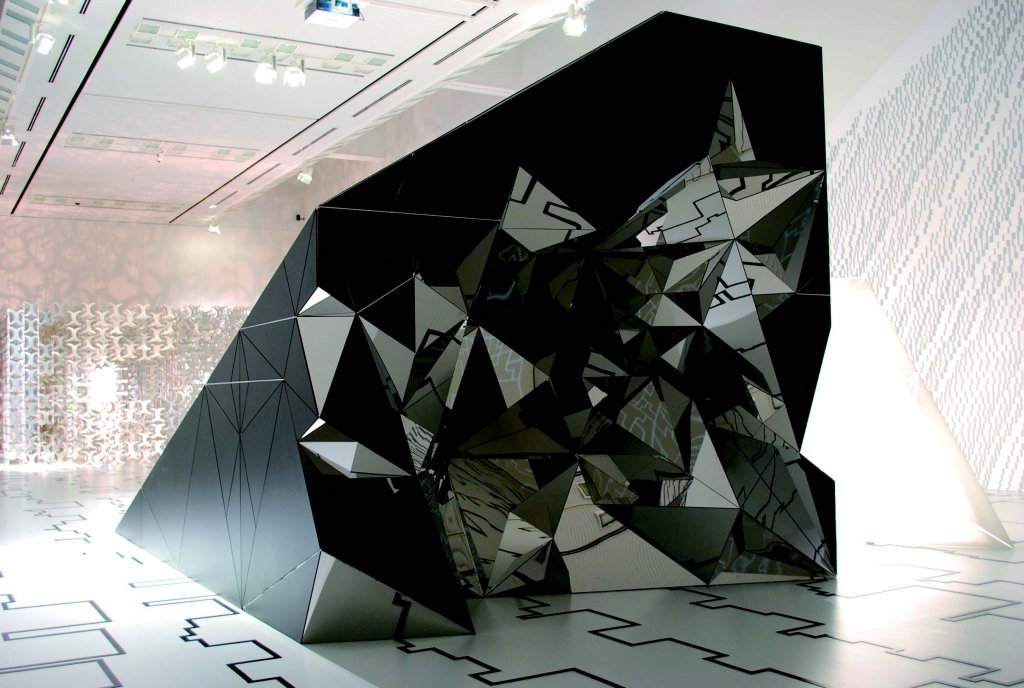by Owen Schaefer
You enter a maze, and that maze is the world―huge photographic banners of leaves, fire, ice, deserts, and forests surround you as walls, with primitive dots and lines sometimes mimicking the natural forms. And as you go through this structure, you find that the banners must be moved aside at times to go forward. The world, after all, is not a puzzle with a single solution. But it is often a mathematical pattern, and as you work your way to the center of things, Cecil Balmond, the author of this structure, lays out a few of his convoluted philosophies as guides for the pieces to come.
It’s not often that one runs across an exhibition of works by a structural engineer, but throughout most of his career, that is the title under which Balmond has worked. But he has also been both author and architect, and the title of this show, Element, is taken from his most recent book―a text that could perhaps be called a work of engineering philosophy. Element, therefore, is less a show of architectural schemata than a presentation of two main works that best embody Balmond’s ideas.
Going through the show’s maze of words and photos, those unfamiliar with the many real-life constructions Balmond has made possible―including the 2002 Serpentine Gallery Pavilion with architect Toyo Ito―might begin to imagine Balmond as a mad mathematician. But setting aside his obsession with the number nine, fractals and Fibonacci numbers, the most fundamental concept in Balmond’s approach to engineering is that, rather than simply finding known solutions to architectural problems, he has built a career of establishing new structural methods, and wrapping them in architecture. The real-life results are often anything but natural in appearance, but Balmond isn’t seeking to reproduce nature’s forms, only the mathematics within them. And when the theory becomes reality, it stands.
Where this becomes most dramatically apparent is in the work entitled H_ edge. At first glance, the structure appears to be made up of chains standing impossibly upright, interspersed with double-crescent-shaped metal cut-outs. Balmond himself has said the idea is at least partly based on the notion of an Indian rope trick―the mythical tale of a conjurer causing a rope to climb into the sky. But upon closer examination, you realize that this is no trick. The metal forms inserted into the chains create tension, which in turn allows more forms to be added. Each aspect of the structure supports the other, where neither would be able to stand on its own. And as if to answer any questions of the stability of such an arrangement, there are window-like cut-outs and corridors which are improbably solid. It is an exercise in almost cellular structure that is unsettling to behold.
The Danzer work consists of two abstract ‘stones’ in a waterless ‘fractal river’ which pours down from a projected waterfall of golden-ratio shapes. The stones themselves are made up of four repeated tetrahedrons of varying sizes, which fit together like a puzzle. Danzer may be a little obtuse for the non-mathematically inclined, but is still impressive in its complexity, challenging the viewer to see it as more than just a hollow skin, but as a collection of interconnected shapes, just as any stone is an arrangement of particles as well.
In the end, Element is a small show with a lot of complex ideas, and while it may swing over the heads of many visitors, it makes up for its grand philosophic-scientific musings with big, bold realizations that won’t require calculus to comprehend.
External Link:
Cecil Balmond Studio









